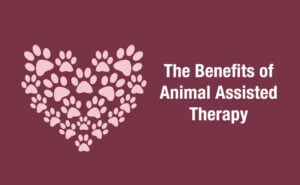Animal-assisted therapy is a type of animal-human interaction in which an animal comes into a home or facility to help improve the lives of people with disabilities, chronic illnesses, or other special needs. Animal-assisted therapy can help reduce stress, increase socialization and even provide mental stimulation for patients in need. We explore what you should know about this awesome practice.
Contents
- 1 What Is Animal-Assisted Therapy(AAT)?
- 2 Theory Behind AAT
- 3 Common Type Of AAT
- 4 What Animal Assisted Therapy is Not?
- 5 Benefits Of Animal Assisted Therapy
- 6 How To Get Started With Animal Assisted Therapy?
- 7 Is It Right For You?
- 8 What To Look For In An Animal-assisted Therapist?
- 9 Tips For Using Animal As Therapist In Your Home
- 10 Conclusion
What Is Animal-Assisted Therapy(AAT)?

The goal of Animal-assisted therapy is to improve the quality of life for people. Especially for those affected by illness or disability, occurs when animals visit people in hospitals, nursing homes, schools, and other institutional settings. The main purpose is to offer socialization and affection to people who might not otherwise receive it. Therapy animals may be dogs, cats, rabbits, horses, birds, and other types of pets. Animals can be natural therapy animals such as dogs and cats but more often they are specially trained therapy animals.
Animal-assisted therapy (AAT) is an increasingly common service provided in health care, social services, and educational settings. This form of therapy involves the interaction between humans and animals to promote healing, growth, development, and quality of life.
Animal-Assisted Therapy (AAT) involves the use of animals in order to help aid the cognitive, social, or physical development of humans. AAT takes many forms, ranging from the use of farm animals to develop nurturing behaviors in young children, to canine visitation teams who might go into a nursing home and bring therapeutic interactions between residents and dogs.
Theory Behind AAT
One theory suggests that physical contact with living creatures calms the central nervous system and promotes a sense of well-being. The human-animal bond is likely responsible for this calming effect. A study conducted in 2009 with individuals diagnosed with intellectual disabilities found that animal contact resulted in an increase in oxytocin, which plays a role in the feeling of trust and bonding.
Animal-assisted therapy dates back to 1897 when Mary Sherwood created a “hospital” for animals. In 1966, Dr. Boris Levinson established the first modern animal-assisted therapy program at the Camden – Atlantic Hospital in New Jersey and there were over 500 programs in the United States and Canada by 1975.
Animal-assisted therapy is defined as an intervention that enhances human well-being through contact with an animal. The human-animal bond has been shown to be a potential source of comfort for people dealing with chronic illness and stress (National Institute on Aging, 2009).
Today we see that this form of therapy is widely accepted by the medical community and society in general. Studies have supported the effectiveness of AAT in reducing emotional distress and improving mood states, even among individuals who are not in rapport with the pet.
Common Type Of AAT

The most known type of AAT is dog-assisted therapy. Animal-assisted therapy has been proven effective for helping children who have been abused, wounded veterans, and individuals with mental illness.
Use of Dog-One popular type of AAT is the use of dogs in programs for children with autism spectrum disorders (ASD). AAT has proven to be extremely effective in calming children with ASD. Dogs are used often in pediatric settings because they do not judge or criticize like humans, and there is something that can be said about dogs’ unconditional love for everyone, even strangers.
What Animal Assisted Therapy is Not?
Unfortunately, the amount of false information out there about animal-assisted therapy has led to a mistaken perception in the public. While a majority of these misconceptions are not intentional, they can still have an effect on how people view AAT and whether or not they would consider it for their child/loved one.
AAT is not:
- Training dogs to be household pets
- Teaching dogs obedience commands /telling them to sit, etc.
- Teaching children how to be good pet owners
Parents who are considering using AAT with their child should know that while it may seem like a very simple solution, there is something else that needs to happen in order for this therapy to “work.”
Animal-assisted therapy is not a quick fix. Animal-assisted interventions are time-consuming and much more involved than simply bringing an animal into the home or hospital/school environment. A good program begins with good training of both the animal and the human handlers. Besides having instructions about care, proper behavioral techniques, effective socialization skills, appropriate play, etc. The animal handlers need to be well-informed about the program, have a thorough knowledge of their own resources. And be able to recognize when the client may need other services.
Benefits Of Animal Assisted Therapy
The use of AAT with these populations is entirely acceptable due to the fact that animals can produce psychological and physiological benefits such as-

- Reducing emotional distress
- Improving mood states
- Providing comfort to those who are chronically ill or stressed
- Providing socialization for those who might not otherwise receive it
- Teaching responsibility and compassion to children
- Providing improved communication skills
- Reduced anxiety and stress
- Increased companionship/socialization
- Decreased loneliness
- Increased self-esteem and body image
- Facilitate expression of feelings (e.g. anger)
- Decrease symptoms of PTSD, depression, and other mental illnesses
- Increase motivation to complete tasks/reduce apathy
- Increased self-care behavior in health impaired individuals
- Improve interpersonal relationships in couples therapy
- Increased number of positive interactions
- Reduce fear and anxiety
- Increased social skills and confidence in children with ASD
- Increased cognitive ability and self-control
- Reduction of physical pain
- Decreased behavioral problems and acting out behaviors (e.g., aggression, withdrawal)
- Increase attention/decrease boredom
- Improved memory retention during educational
These are some benefits of Animal-assisted Therapy for people with ASD. Animal-assisted therapy also has proven to be successful with children who have been abandoned by their parents, abused, or even the victims of war.
How To Get Started With Animal Assisted Therapy?

One of the best ways to get started with Animal Assisted Therapy is to do some research online. There are many reputable sources of information that can help you learn more about AAT and how it can help your loved one. You can also find lists of certified AAT providers in your area.
Once you have a better understanding of what AAT is and how it works, the next step is to find an appropriate provider. Not all animal-assisted therapy programs are the same. So it is important to do your research and find one that meets your specific needs.
It is also important to establish a good rapport with the provider and make sure both the animal and the person receiving therapy are comfortable with one another. Also, be sure to ask the therapist questions about their experience and the type of training they have had. It’s important that your loved one receives appropriate care.
Is It Right For You?
As with any therapy or treatment option, it is important to consider all available options before making a decision. Weigh out the pros and cons and discuss with your loved ones how AAT will potentially benefit them. If you decide that animal-assisted therapy is right for you or your loved one. There are many positive results awaiting you. While animal-assisted therapy is an effective intervention, it also has some possible problems. Volunteers have to be screened for things like tuberculosis and other communicable diseases.
AAT can benefit many individuals, however, it is important that the parent/caregiver also looks at all other options available before making a decision on AAT. AAT is not a guaranteed solution. There must be an established rapport between the animal and the child/adult in order to obtain the full benefits. Many studies have shown that when this relationship was unable to take place, AAT did not prove to be effective.
What To Look For In An Animal-assisted Therapist?
When looking for a therapist who uses animal-assisted therapy, it is important to consider the following:
The provider’s experience and training: Make sure the therapist has enough experience and training in using animal-assisted therapy. The animal should also be comfortable with the person receiving therapy.
The type of animal-assisted therapy: Not all programs are equal or similar. So make sure the program you choose offers the type of therapy that will best benefit your loved one.
The therapist’s approach to AAT: Make sure the therapist’s approach to AAT is respectful of both the animal and the person receiving therapy.
The location and availability of services: Make sure the therapist is available in a location that is accessible to you or your loved one.
Compatibility: Make sure the therapist is comfortable with working with your family, including siblings and parents. It’s important that all of the parties involved are comfortable with one another.
Compensation: Make sure your insurance is covering the therapist and program you are choosing. Search for providers and programs that offer sliding scales and payment plans if needed. If you’re paying out of pocket, it’s important to ask about pricing before receiving services. Therapy sessions cost anywhere from $45 to $100 each hour.
Medical Assistance: Make sure the therapist is willing to work with your primary care physician and other medical specialists.
Animal-assisted therapy helps children open up about their feelings in a safe environment, allowing both child and animal to benefit from physical contact, unconditional love, and acceptance.
Tips For Using Animal As Therapist In Your Home
These are just some of our tips for using animals as therapists in your home.

- Invite an animal into your home for a therapy session when the home is calm.
- Do not ask animals to do therapy work when they are under stress, hungry.
- Never force an animal to work if it doesn’t want to. Let them take their time and explore at their own pace.
- Use positive reinforcement sessions sparingly. It is best to save these for the moments when you really need them so that the animal will be more receptive when you do use them.
- If the animal seems stressed or you start to get that way, it is time to call off the session.
- Don’t expect immediate results. Animal-assisted therapy is often a long process and many times do not yield short-term effects.
- Do not put animals in danger, no matter how much they want to help.
- Do not force people to interact with the animal. Let them do so at their own pace and when they feel comfortable.
- Always follow all proper safety precautions for children under 18. The child should be under observation by someone 16 or older when interacting with an animal in therapy work. And there should always be a barrier such as a leash, fence, wall, or crate in place so that the child will not have direct contact with the animal.
- Keep animals healthy by keeping them up to date on all medical treatments and providing them with an appropriate diet.
- Always keep animals out of bedrooms. If you are using them in therapy in a bedroom, always ensure to close the doors at night so that they cannot escape.
- Never leave children under 18 alone with animals for therapies or any other reason.
Conclusion
Animal-assisted therapy is a powerful tool when it comes to helping people of all ages and backgrounds. From providing the type of therapy that will best benefit your loved one, to tips and tricks for using an animal as a therapist in your home, there are many ways you can incorporate animals into therapeutic sessions.
If you are looking for affordable Online Counseling MantraCare can help: Book a trial therapy session


